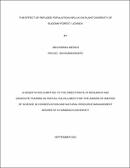The effect of refugee population influx on plant diversity of Bugoma forest, Uganda
Abstract
Refugee population is one of the causes of land and environmental degradation in refugee
hosting countries. However, the relationship between forest plant diversity and refugee
population influx is not well documented. This study assessed the effect of refugee population
influx in Kyangwali Refugee settlement on plant diversity of Bugoma Forest in Uganda.
Sentinel 2 imagery data for the study area for 2016, 2018, 2020 were used for vegetation cover
and land use change analysis using QGIS 3.12 and 296 households were randomly surveyed for
socio economic data. A total of 1,091 plant counts were recorded in 18 plots for computation of
plant species diversity and richness. Simpsons diversity for tree species ranged between 0.4562
to 0.9583 for Kyangwali block accessed by refugees and 0.7873 to 0.9979 for Muhangaizima
block accessed by host community . A higher Shannon weiner index of 2.4836 was recorded in
Muhangaizima block compared to 2.0106 for Kyangwali block. Grasslands experienced the
biggest vegetation cover loss (11.09%) followed by woodland (2.73%) and the tropical high
forest (0.85%) while subsistence farming and built up land uses increased by 11.8% and 2.09%
respectively for the study period 2016 to 2020 that coincides with the biggest refugee
population influx in Kyangwali refugee settlement. Whereas refugees and host community accessed
forest resources mainly fire wood, charcoal and building materials from Bugoma forest for cooking energy,
livelihood and building construction, the dependence on Bugoma forest as a source of these resources was
higher for refugee households than the host community. Pearson’s correlation coefficient revealed a
positive relationship between the plant diversity and quantity of firewood used by the refugee
households (r=0.047, p=0.004, n=296) and frequency of collecting forest resources (r=0.011,
p=0.002, n=296). Therefore, the refugee population influx in Kyangwali refugee settlement to a
large extent contributed to decrease in plant diversity of Bugoma forest. However, other
underlying factors affecting plant diversity in Bugoma forest require further studies

